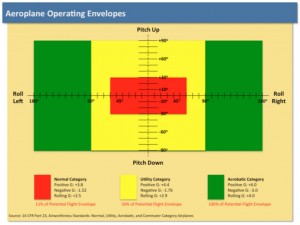 In documents ICAO has circulated, their recommendations call for the delivery of Upset Prevention and Recovery Training (UPRT) to all pilots prior to Commercial Licensing. This training would take place “in actual flight” meaning in an all-attitude / all-envelope capable airplane rather than a simulator.
In documents ICAO has circulated, their recommendations call for the delivery of Upset Prevention and Recovery Training (UPRT) to all pilots prior to Commercial Licensing. This training would take place “in actual flight” meaning in an all-attitude / all-envelope capable airplane rather than a simulator.
According to a ICAO document, the Manual on Aeroplane Upset Prevention and Recovery, UPRT takes an integrated approach that identifies academic and practical training resources “to provide pilots with the necessary knowledge, skills, and attitudes to reduce the probability of an upset encounter and to maximize their ability to recover from such an event.”
Practical training resources include the use of airplanes and Flight Simulation Training Devices (FSTDs). It is the on-airplane experience, however, where theory truly becomes reality; where pilot stress levels can be manipulated to levels comparable to those of real-life upsets, but in a controlled learning environment where techniques can be perfected and the bonds to mental models for recovery can be cemented. It is the on-airplane component where pilots gain necessary confidence in the training methodology and where the recurrent training mindset is fostered.
The on-airplane component includes, among other things, intentional training operations near and above the critical AOA and to extreme bank angles not encountered during routine flight. Regardless of the airplane being used, the safe and legal delivery of UPRT requires due consideration of the training airplane’s approved operating limitations, design limits, and available margins of safety.
Here is a graph of pitch and roll attitudes that shows the minimum limit loads of the Normal, Utility, and Acrobatic Categories:
Note the “Rolling G” limitations. This is due to the fact that if you apply an asymmetric load, as in rolling and pulling at the same time, a common student error, reductions of up to one third of the structural load limits can be encountered.
There have been important conversations taking place regarding what aircraft should be used in the delivery of UPRT; specifically what category of certification. As obvious as the choice of an aircraft certified in the Acrobatic Category would seem, there are some that have argued that the lack of availability of Acrobatic Category aircraft in some parts of the world make the requirement to utilize an aerobatic aircraft for this type of training too limiting.
A parallel to this argument can be found with regard to a different type of training platform: Full Flight Simulators. Level C or Level D full motion flight simulators are required for the training and testing of all commercial airline pilots worldwide, with very few exceptions. These FSTDs can cost anywhere from 5 to 25 million US dollars. These flight simulators are not available in every country on the globe. It is very common for pilots to fly to wherever appropriate devices are located for annual or semi-annual recurrency training and checking.
Obviously, the capital outlay for an aerobatic aircraft at less than a half million US dollars is significantly less than a Full Flight Simulator, and they are much easier to move about!
Loss of Control-In flight (LOC-I) is the leading cause of fatalities in worldwide aviation. ICAO agrees that there are elements of training that must be experienced in flight since no simulator can replicate the necessary aerodynamics, let alone the emotional impact that UPRT in actual flight can deliver.
Someday, we will hopefully look back on a reduction of LOC-I accidents as a result of better training using all-attitude / all-envelope aircraft to deliver UPRT. Successful delivery of training in that environment calls for the use of aircraft certificated in the Acrobatic Category in order to maintain the appropriate margin of safety in the delivery of UPRT.





I resist MANDATORY training details. I would hope all pilots would get aerobatic instruction/time, glider instruction and upset recovery instruction in both real aircraft and simulators. Each has a place.
Hello Bob, we heartily agree with your philosophy. We firmly believe that there are important lessons which can be learned through many different mediums and training platforms which can all make us smarter, more skilled, and safer aviators. Interestingly, ICAO and IATA also subscribe to this line of thinking, as they both call for an integrated approach to flight training which combines the best elements of academic, on-aircraft training in the all-attitude/all-envelope environment, and a flight simulator used within its valid training envelope.
I can’t believe anyone is seriously considering endorsing UPRT in anything other than aerobatic category aircraft. I’ve had clients accidentally exceed the Positive G limit of our aerobatic aircraft in their very first attempt at a UPRT maneuver. They just didn’t know until they knew. If that had been a utility or normal category aircraft I might not be writing this. A few structural failures in normal category aircraft in UPRT and we would be right back in the dark ages of being afraid to train to true proficiency and kicking the can down the road to operational accidents.
Don, thank you so much for your comment. It really boils down to the concept of Margin of Safety. Even though an airplane used in the delivery of UPRT should normally be flown in a manner which mirrors the limit load of the airplane being emulated (a minimum of 2.5 G for a Transport Category aircraft, for example), we have to remember that it is being used in a training role. One of the reasons for UPRT is learning to manage G levels appropriately, and occasionally as a result of the trial-and-error by which humans learn, excess G can unintentionally be applied. An airplane with an appropriate margin of safety can take such experiences in stride. The training done for UPRT can be as safe as other forms of flight training if the appropriate operational considerations and instructor qualifications are in place.
When I taught UPRT, we called it Recovery From Unusual Attitudes back then, in the Royal Air Force in the 1960’s and 70’s we emphasised one key thing on every training sortie. “Unload the aeroplane BEFORE rolling the wings level.
We had a mantra that we instilled into every pilot we trained.
1. Unload the aeroplane
2. Check if the aeroplane is climbing or descending
* If Climbing go to full power
* If descending power to idle, air brakes out
3. Roll to wings level using the turn needle
4. Using the altimeter bring the aeroplane back to level flight.
This worked every time.
The key thing was of course that as RAF instructors we had specific training in the teaching of UPRT and I believe that this should be a pre-requisite before any one is allowed to carry out UPRT training.
One of the things we had going for us was the turn and slip. This always showed the way the aeroplane was rolling and using the roll controls in the direction opposite to the turn needle always enabled you to level the wings.
Hi William,
Thank you for your feedback and listing of RAF unusual attitude procedure. We had a very similar process we taught our RCAF students. There are quite a lot of similarities between your listed process with international guidance on upset training such as ICAO Doc 10011: Manual on Aeroplane Upset Prevention and Recovery Training (UPRT). The differences are primarily due to UPRT also including stall recovery and a more comprehensive approach to stabilizing the airplane post-recovery. All in all, it’s a good reminder to us all that the military has been effectively instilling simple and effective strategies in pilots to overcome situations associated with Loss of Control In-flight (LOC-I) for many, many decades that the civilian world has, for the most part, over-looked until recently (2012’ish onward). Thank you again for your comment, William!
The responsibility for the problem, that we have a few generations of pilots that have no clue about UPRT or flying pitch and power, when confronted with unreliable airspeed, rests solely on the shoulders of the authorities, well in Europe anyway. In 2000 the decision was made to remove spin training from the PPL syllabus and we are paying the penalty of that decision now. I believe it was mainly a financial decision as flying schools did not want the extra cost of keeping aerobatic capable aircraft serviceable. Good training always costs money, and when decisions are made to save money without looking at the long term implications, we arrive in the situation we are now confronted with. UPRT as you teach is excellent, to try to remedy the problem, but the syllabus of basic PPL training must be revised so UPRT is instilled into all pilots from day one in an aircraft.